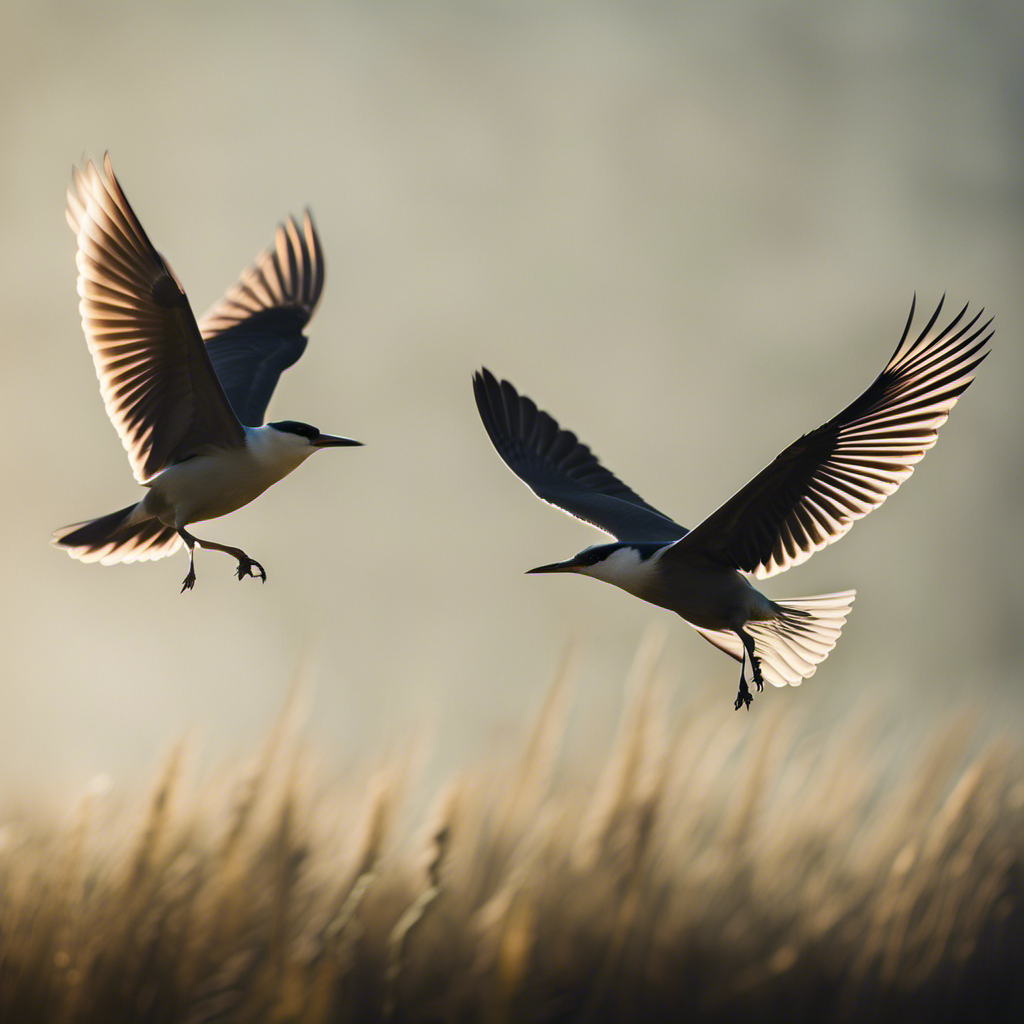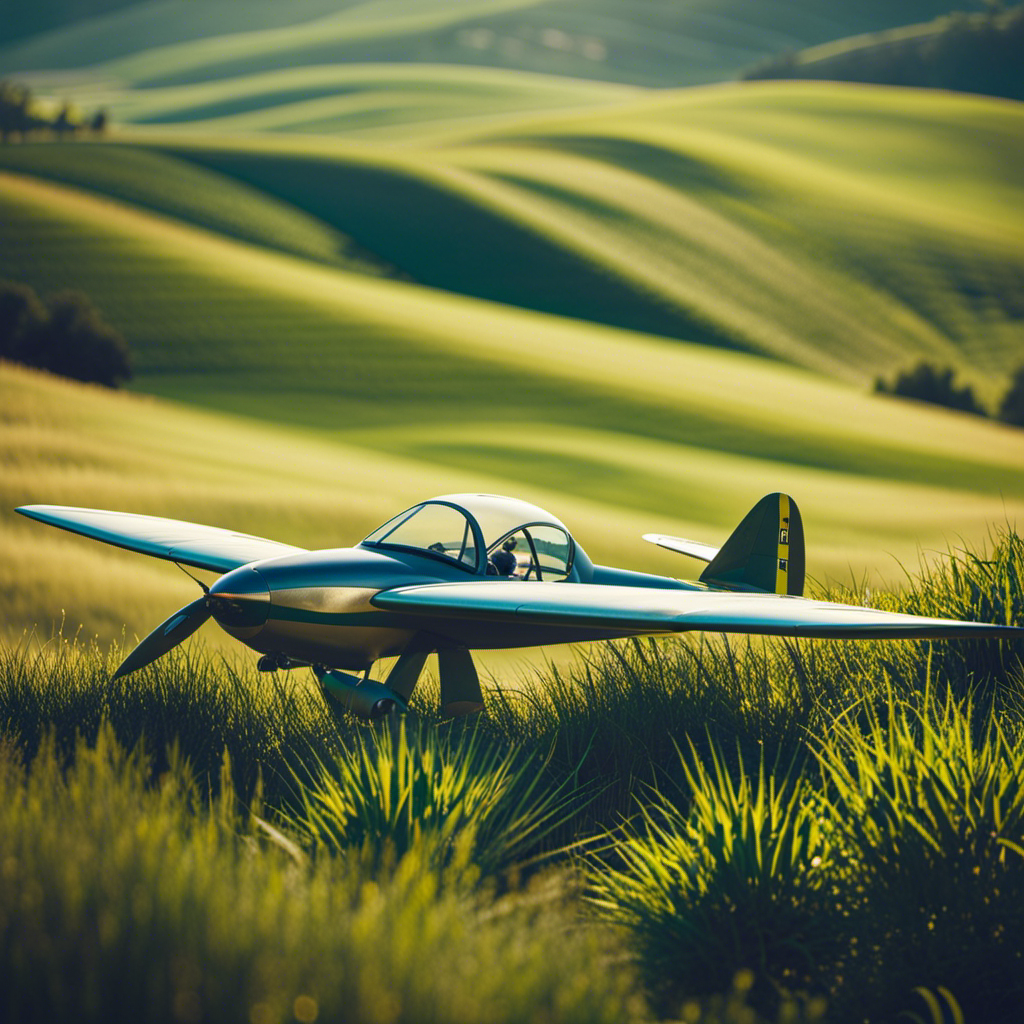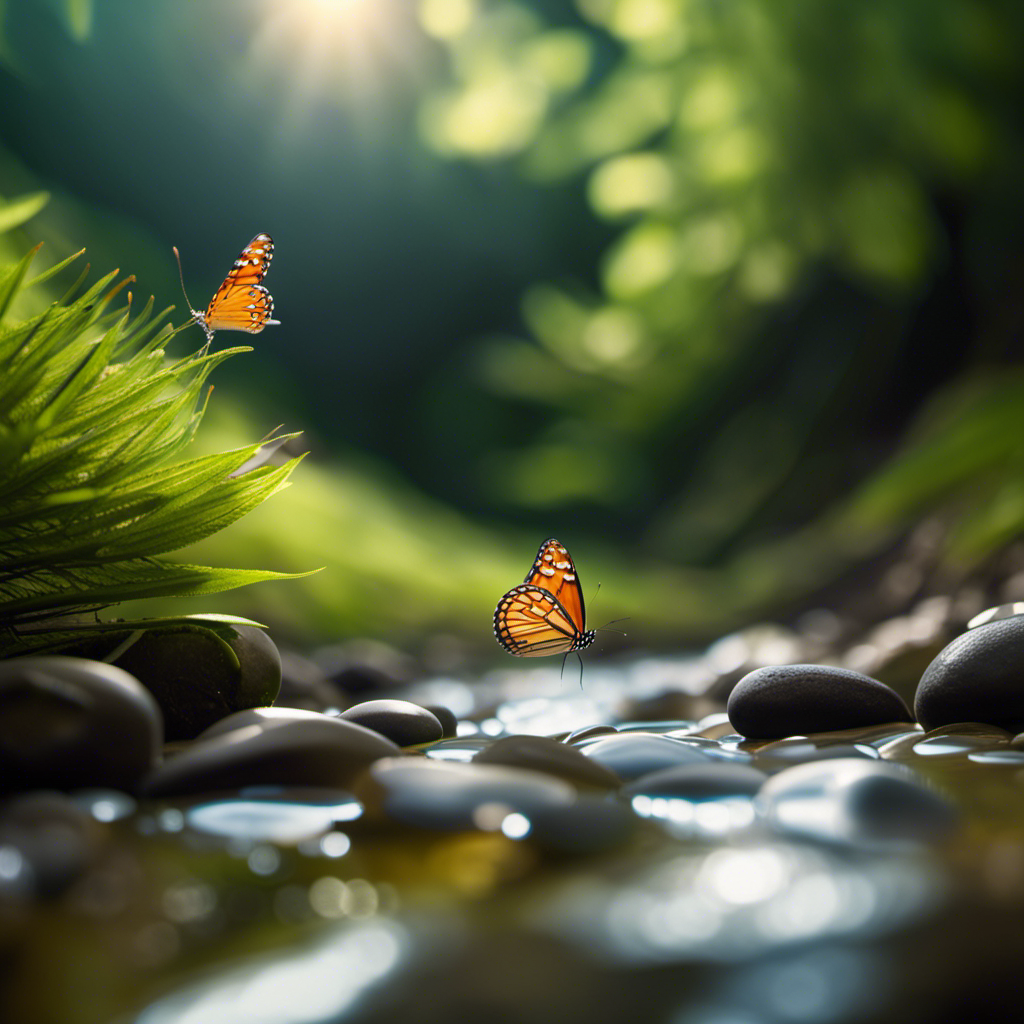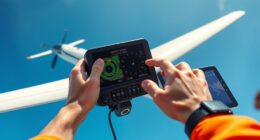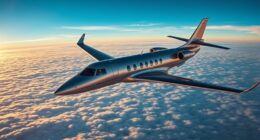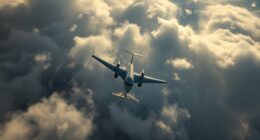Have you ever considered how animals are able to glide through the air or flap their wings to take flight?
Well, here’s an interesting fact for you: did you know that there is a distinct difference between gliding and flapping?
In this article, we’ll delve into the world of aerodynamics to explore the scientific, detailed, and technical aspects of both gliding and flapping.
So, grab your curiosity and let’s dive into the fascinating world of animal flight!
Key Takeaways
- Gliding is an efficient mode of travel that covers large distances and allows access to new food sources, while flapping provides speed, agility, and the ability to outmaneuver predators and catch prey.
- Flapping animals can change direction quickly, evade predators, and capture prey, while gliders rely on air currents and body shape to stay aloft.
- Some birds and insects can hover in mid-air without forward or backward movement, achieved through rapid wing flapping and precise wing movements.
- Gliding has limitations such as limited control over speed and altitude, dependence on wind currents, and inability to ascend or descend rapidly, while flapping has limitations like higher energy demand, increased muscle fatigue, and larger wing surface area making navigation through narrow spaces challenging.
Understanding Gliding and Flapping
Gliding and flapping are two distinct types of wing movements in birds.
Gliding refers to a mode of flight where birds maintain a steady horizontal movement through the air without actively flapping their wings. Instead, they rely on the momentum gained from an initial burst of flapping or by utilizing updrafts and air currents. Gliding is often observed in birds such as hawks, eagles, and albatrosses, who have long, broad wings that allow them to soar effortlessly for extended periods.
On the other hand, flapping is the primary mode of flight for most birds. It involves the rhythmic movement of wings, consisting of both upward and downward strokes. Flapping generates lift and thrust, enabling birds to maneuver in the air, change altitude, and achieve sustained flight. This continuous wing movement requires significant energy expenditure and is essential for birds to take off, land, and navigate effectively.
Transitioning to the subsequent section about animals that glide, it is interesting to note that gliding is not exclusive to birds. Many other animals, such as flying squirrels, sugar gliders, and even reptiles like flying dragons, have evolved the ability to glide through the air.
Animals That Glide
Some animals that glide through the air include squirrels, sugar gliders, and flying squirrels. Gliding is a fascinating adaptation that allows these creatures to move through the air with grace and ease. As you observe these gliding animals, you may notice several key characteristics:
- Specially adapted limbs and body structures that enable gliding, such as elongated limbs and a patagium, a flap of skin that acts like a parachute.
- Agile movements that allow for precise control and navigation while in flight.
- Utilization of different gliding techniques, such as soaring, parachuting, or gliding in a straight line.
- Varied habitats in which these animals can be found, from forests to savannas.
Now, let’s delve into the world of animals that flap, where the ability to generate lift through wing movements allows for more sustained flight and maneuverability.
Animals That Flap
When animals flap their wings, they are able to generate lift and achieve sustained flight. Flapping involves the rapid movement of wings up and down, creating a force that propels the animal through the air. This movement is powered by the contraction of muscles attached to the wings.
As the wings move downward, they create an upward force called lift, which counteracts gravity and allows the animal to stay airborne. The shape and angle of the wings, along with the frequency and amplitude of the flapping motion, play a crucial role in determining the efficiency and maneuverability of flight.
Understanding the aerodynamics of flapping is essential for studying the intricate flight patterns and capabilities of animals. Transitioning into the subsequent section about the aerodynamics of gliding, we can explore how different animals utilize gliding as a means of locomotion.
Aerodynamics of Gliding
The efficiency of flight in gliding animals is influenced by factors such as wing shape, angle of attack, and airspeed. Gliders have evolved various wing shapes to optimize lift and minimize drag. For example, birds of prey have long, slender wings, while flying squirrels have flaps of skin that extend between their limbs. The angle of attack, or the angle at which the wing meets the oncoming airflow, also affects gliding efficiency. By adjusting their wing position, gliding animals can control their lift and descent. Additionally, airspeed plays a crucial role in gliding. Increasing airspeed allows gliders to generate more lift and cover greater distances. To help visualize the differences, here is a comparison table showcasing the wing shapes, angles of attack, and airspeeds of different gliding animals:
| Animal | Wing Shape | Angle of Attack | Airspeed |
|---|---|---|---|
| Bird of Prey | Long, slender | Moderate | High |
| Flying Squirrel | Flaps of skin | Steep | Medium |
| Sugar Glider | Flaps of skin | Steep | Low |
Understanding the aerodynamics of gliding animals is crucial for comprehending the mechanics behind their flight. Now, let’s delve into the fascinating world of the aerodynamics of flapping.
Aerodynamics of Flapping
In the study of the aerodynamics of flapping, it is important to understand the concepts of lift and drag. Lift is the force that acts perpendicular to the direction of motion and allows flapping animals to stay airborne.
Drag, on the other hand, is the resistance to forward motion and must be minimized to maximize efficiency.
Additionally, wing shape and size play a crucial role in the aerodynamics of flapping animals, as they directly impact lift and drag forces. The shape and size of the wing determine the airflow patterns and the ability of the animal to generate lift and reduce drag, ultimately affecting its flight performance.
Lift and drag in flapping
There’s a difference in the lift and drag experienced during flapping compared to gliding.
When a wing flaps, it generates both lift and drag forces. The lift force is produced by the motion of the wing and is responsible for keeping the animal airborne. The drag force, on the other hand, opposes the forward motion of the wing.
During flapping flight, the wing moves in a complex motion, resulting in the generation of both lift and drag forces. The magnitude and direction of these forces depend on various factors such as wing shape, wing size, and the angle of attack.
Understanding the aerodynamics of flapping flight requires a detailed analysis of these forces in relation to the wing shape and size in flapping animals.
Wing shape and size in flapping animals
Wing shape and size greatly affect the lift and drag forces experienced during flapping flight. The shape of the wing, specifically the aspect ratio, determines the efficiency of flapping flight. Birds with high aspect ratio wings, such as albatrosses, experience low drag and high lift, allowing them to cover long distances with minimal energy expenditure.
Conversely, birds with low aspect ratio wings, like hawks, generate more lift but also experience higher drag, making them better suited for maneuverability and agility.
Additionally, the size of the wing impacts the amount of lift generated. Larger wings provide more surface area for the generation of lift, allowing birds to carry heavier loads or glide for longer periods. This transition from flapping flight to gliding flight offers several advantages, such as energy conservation and extended time aloft, which will be discussed in the following section.
Advantages of Gliding
The advantages of gliding are that it allows animals to travel long distances without expending much energy. Gliding is a form of locomotion in which an animal moves through the air by using the natural forces of wind and gravity. This efficient mode of travel is made possible by the unique adaptations of gliding animals. One advantage of gliding is the ability to cover large distances quickly. By gliding, animals can take advantage of updrafts and air currents, allowing them to travel long distances with minimal effort. Additionally, gliding enables animals to access new food sources and avoid predators. Some examples of animals that are capable of gliding include flying squirrels, sugar gliders, and flying lemurs.
| Advantages of Gliding | |
|---|---|
| Efficient mode of travel | |
| Covers large distances | |
| Access to new food sources | |
| Avoidance of predators | |
| Utilizes updrafts and air currents |
This efficient way of moving through the air is in contrast to the advantages of flapping, which will be discussed in the next section.
Advantages of Flapping
When it comes to the advantages of flapping, you possess an innate ability for speed and agility. By flapping your wings rapidly, you can generate enough lift and thrust to maneuver swiftly through the air, enabling you to outmaneuver predators or catch elusive prey.
Furthermore, your ability to hover sets you apart from other creatures, allowing you to maintain a stationary position mid-air, which is beneficial for tasks such as foraging or searching for a suitable nesting site.
Speed and agility
Speed and agility are crucial in determining the difference between gliding and flapping. When it comes to flapping, birds and insects possess the ability to generate lift and propulsion through the rapid movement of their wings. This allows them to navigate through the air with precision and control. The speed at which they flap their wings is directly linked to their ability to generate lift and maintain flight.
Additionally, the agility of their movements allows them to change direction quickly, evade predators, and efficiently capture prey. These characteristics set flapping animals apart from gliders, which rely on the air currents and their body shape to stay aloft.
The ability to hover, another remarkable feat of flapping creatures, will be discussed in the next section.
Ability to hover
Now that you understand the speed and agility of gliding and flapping, let’s delve into the ability to hover.
Hovering is a fascinating capability possessed by some birds and insects, allowing them to stay suspended in mid-air without any forward or backward movement. The ability to hover is primarily achieved through the rapid flapping of wings, which generates enough lift to counteract the force of gravity. This continuous flapping motion creates a stable air cushion beneath the wings, allowing the organism to remain stationary in the air.
Hovering is an energy-intensive maneuver that requires precise wing movements and muscular control.
Now, let’s explore the limitations of gliding, which arise due to the inherent design and physiology of gliding organisms.
Limitations of Gliding
One of the limitations of gliding is that it doesn’t allow for quick changes in direction. Gliding is an efficient way for birds and other animals to travel long distances, but it lacks the maneuverability required for sudden turns or evasive actions. This constraint arises due to the lack of an active propulsion mechanism during gliding.
Here are five additional limitations of gliding:
- Limited control over speed and altitude
- Dependence on external factors such as wind currents
- Inability to ascend or descend rapidly
- Susceptibility to turbulence, which can disrupt the glider’s path
- Reliance on elevated starting points or thermal updrafts for sustained flight
These limitations highlight the specialized nature of gliding as a flight strategy. However, they also pave the way for the development of an alternative mode of flight called flapping, which overcomes some of these constraints. In contrast to gliding, flapping allows for greater agility and control, enabling creatures to navigate complex environments more effectively.
Limitations of Flapping
Don’t forget that while flapping provides greater maneuverability, it also requires more energy and stamina on your part. Flapping involves the rapid movement of wings, generating lift and thrust to keep you in the air. However, this constant motion comes with its limitations. Firstly, it demands a higher metabolic rate, causing increased energy expenditure. Your muscles must work harder and for longer durations, leading to quicker fatigue. Secondly, the continuous motion of flapping can result in greater wear and tear on your wing muscles and joints. Over time, this can lead to injuries and decreased performance. Lastly, the constant flapping requires a larger wing surface area, making it challenging to navigate through narrow spaces. Remember, while flapping offers advantages, it also comes with its trade-offs.
| Limitations of Flapping |
|---|
| Higher energy demand |
| Increased muscle fatigue |
| Greater risk of injury |
Frequently Asked Questions
How do animals that glide or flap differ from animals that don’t have the ability to do either?
Animals that glide or flap differ from those that lack these abilities in terms of locomotion and survival strategies. Gliding animals rely on air currents to move horizontally, while flapping animals use wing movements to generate lift and propel themselves through the air.
Are there any animals that can both glide and flap?
Yes, there are animals that can both glide and flap. Some examples include flying squirrels, sugar gliders, and flying lemurs. These animals have adaptations that allow them to both glide through the air and actively flap their wings or limbs.
Are there any specific adaptations in the wings or body structure of animals that glide or flap?
In order to glide or flap, animals have developed specific adaptations in their wing and body structures. These adaptations enable them to achieve efficient flight, whether it be through soaring effortlessly or flapping with power and precision.
How do the aerodynamics of gliding and flapping differ?
The aerodynamics of gliding and flapping differ in several ways. Gliding relies on passive forces like gravity and air currents, while flapping involves active wing movements to generate lift and thrust. The wing shape and angle of attack also vary between the two.
What are the main advantages and limitations of gliding compared to flapping?
Gliding offers the advantage of efficient energy use and extended flight time, while flapping allows for maneuverability and the ability to generate lift. However, gliding is limited by the need for a source of initial height or launch.
Conclusion
So there you have it, folks! After delving into the intricate world of gliding and flapping, we can confidently say that these two modes of locomotion are as different as night and day.
While gliding allows certain animals to gracefully soar through the air, flapping is the tried-and-true method for those who prefer a more hands-on approach.
From the fascinating aerodynamics to the unique advantages and limitations, the world of gliding and flapping is truly a marvel of nature.
Next time you see a bird soaring or a flying squirrel gracefully gliding, take a moment to appreciate the incredible science behind their movements. It’s a sight that will surely leave you in awe!
With a heart that soars as high as the skies, Aria, affectionately known as “Skylark,” is the driving force behind Soaring Skyways. Her journey into the gliding world began as a young dreamer gazing up at the soaring birds, yearning to experience the weightlessness and freedom they embodied. With years of experience both in the cockpit and behind the scenes, Aria’s commitment to the gliding community is unwavering.
